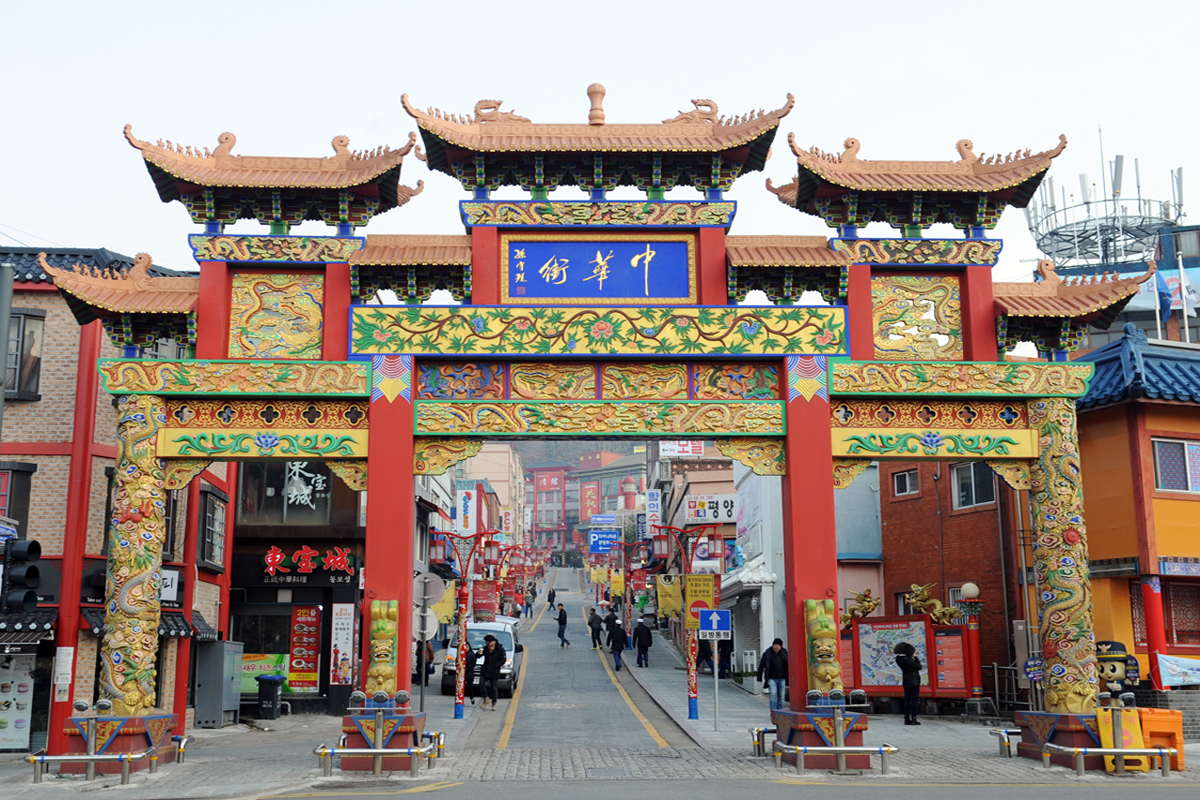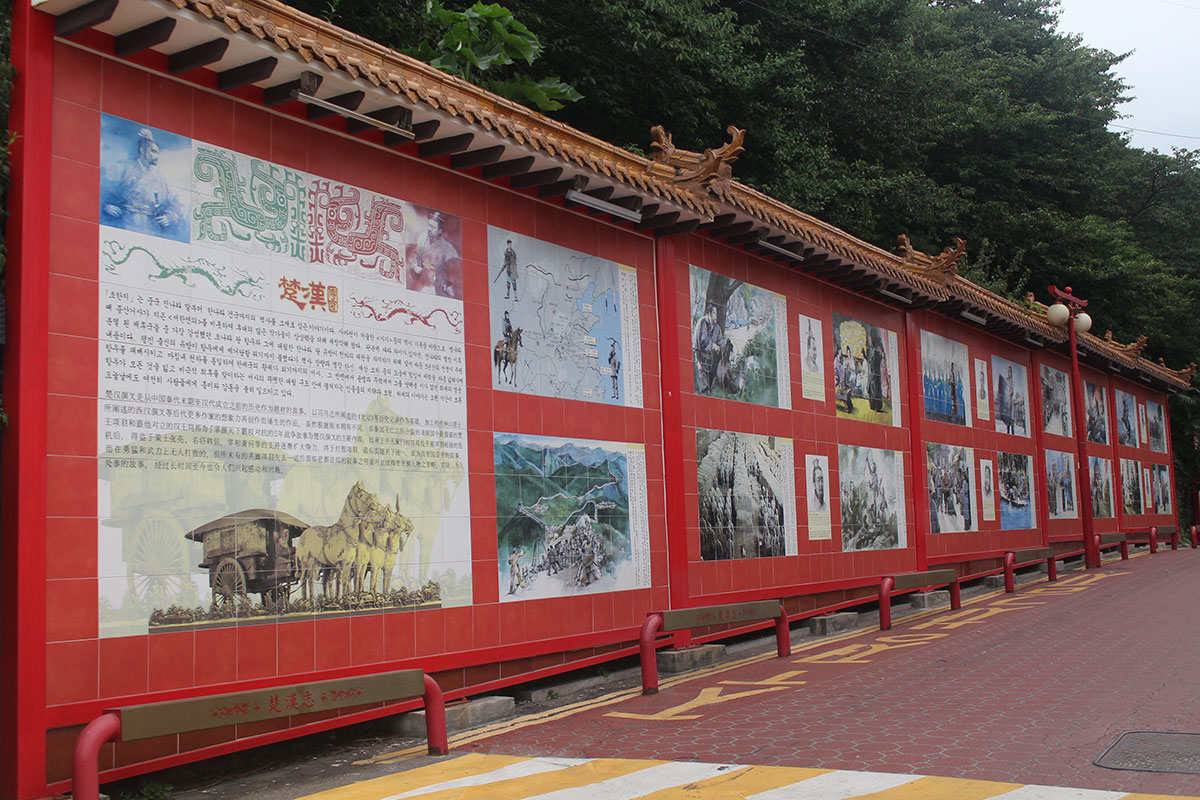Chinatown and Fairy Tale Village Story Course
Chinatown and Fairy Tale Village Story Course
Chinatown, or the "Little China in Korea", is where Korean and Chinese cultures coexist, and was formed when the Cheongguk Consulate was established in 1884 and more than 2,000 Chinese people migrated to the current Seonlin-dong area.
- 1
 PailouWhile making your way to Chinatown, you will see the pailou that indicates its start.
PailouWhile making your way to Chinatown, you will see the pailou that indicates its start.
Four pailous (gates) mark the borders of Chinatown: Junghwaga, Seonlinmun, Inhwamun, and Hanjungmun. It is a structure that serves as a spiritual support for the Chinese, and it is said that these village gates were built at the entrance of neighborhoods since ancient times.
It is traditionally shaped like a pagoda with a roof topped on red pillars, and features ornate decorations. These elaborate and beautiful decorations and vivid coloring catch the eye.
Pailous signify prayers for the prosperity of the shopping district by expelling unclean things such as ghosts. - 2
 Korean-Chinese Cultural CenterThe Korean-Chinese Cultural Center was established by the Jung-gu Office to revitalize Chinatown and to enjoy friendly relations with China.
Korean-Chinese Cultural CenterThe Korean-Chinese Cultural Center was established by the Jung-gu Office to revitalize Chinatown and to enjoy friendly relations with China.
It is a place where cultural exchanges between Korea and China take place, and you can compare the two countries' histories, cultures, economies, societies, and lives.
A variety of attractions, such as permanent weekend performances, free movie screenings, and special exhibitions are offered. - 3
 Hanjungwon Resting PlaceWhen you leave the Korean-Chinese Cultural Center and follow the back road, there is a small resting place called Hanjungwon.
Hanjungwon Resting PlaceWhen you leave the Korean-Chinese Cultural Center and follow the back road, there is a small resting place called Hanjungwon.
It is a space that recreated a traditional Chinese garden of the Qing Dynasty, and you can rest your travel-weary legs there. It is a resting place in Chinatown as well as an outdoor cultural space you can peacefully visit. - 4Cheongil Settlement Boundary StairsSettlements were sometimes established out of economic motives, but some were built following aggression and colonization as military and political goals.
Settlements in Korea were established through the invasion of imperialist countries and the signing of an inequality treaty.
The Cheongil Settlement Boundary Stairs are where traces of this painful history, along with settlements of Qing China and Japan, can be seen. - 5Three Kingdoms Mural StreetAs you go along the streets of Chinatown, the Three Kingdoms Mural Street spreads out on both walls of the road that rises above the stairs of the Cheongil Settlement.
You can also follow along on the food street, but the chronological order of the stories would be reversed so you would not be able to appreciate the proper story flow.
The recommended order of seeing the mural paintings is best accomplished by walking down the hill. The Three Kingdoms Mural Street is one of the representative attractions in Chinatown that summarizes the overall story of the Three Kingdoms. - 6
 Chohanji (Legend of Chu and Han) Mural StreetThe Chohanji Mural Street is a street where large murals of representative events and characters of Chohanji are displayed.
Chohanji (Legend of Chu and Han) Mural StreetThe Chohanji Mural Street is a street where large murals of representative events and characters of Chohanji are displayed.
You can enjoy a time travel journey from the end of the Qin Dynasty to the founding of the Han Dynasty while strolling the 110m long mural street. - 7
 Chinatown StreetChinatown, a Chinese-style street colored with red signs and red lanterns.
Chinatown StreetChinatown, a Chinese-style street colored with red signs and red lanterns.
This exotic place is an area where, after the Qing China Consulate was established at the time of the port's opening, the Chinese people who lived here formed their own culture.
As a small China in Korea, in addition to numerous Chinese restaurants, it is full of attractions as diverse as Three Kingdoms and Chohanji Mural Streets, pailous, the Korean-Chinese Cultural Center, and the Cheongil Settlement Stairs. - 8UiseondangUiseondang (義善堂) means to keep righteousness and live well.
The year of its establishment is not known exactly, but it is a Chinese-style shrine built as the number of Chinese residents in Incheon increased after the Incheon Port opened, praying for their solidarity and edification, and for the shipstraveling to and from China. As it is a shrine, a reverent and quiet attitude is needed while visiting it. - 9Jajangmyeon Museum (black bean noodles museum; formerly Gonghwachun)The Jajangmyeon Museum is located in the old Gonghwachun building, the original house of jajangmyeon. Here, you can see the history of and information about jajangmyeon created by the Chinese.
The kitchen and meals of the old Chinese restaurant (Gonghwachun) are also reproduced. It will be a fun experience to look at the changes in jajangmyeon by period from the days when there was no Chunjang or caramel sauce. - 10
 Songwol-dong Fairy Tale VillageYou can meet the heroes of children's books that you read as a child in Jung-gu, Incheon.
Songwol-dong Fairy Tale VillageYou can meet the heroes of children's books that you read as a child in Jung-gu, Incheon.
It is a small fairy tale village that has the pretty name “Songwol” because the moon and pine forest go very well together.
The entire village is a special photo zone, and it is a tourist spot where both adults and children can go on a trip through fairy tales while looking for the heroes hidden in alleyways.
